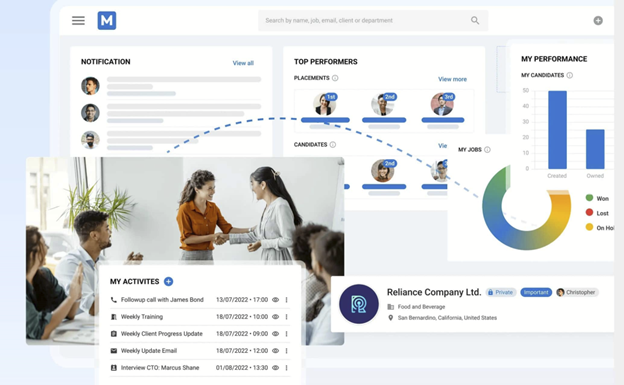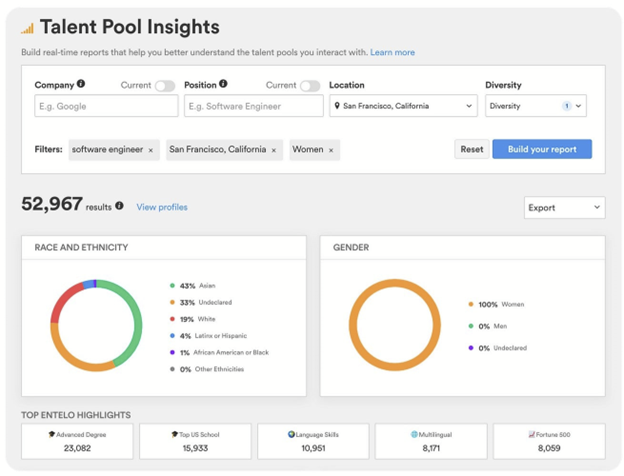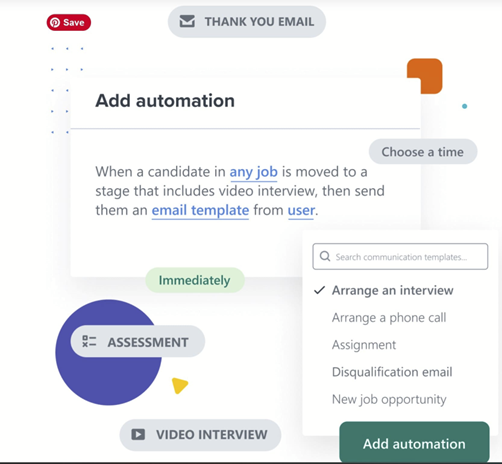Today recruiting teams receive large amounts of candidacies for each open position. Manually processing mountains of resumes becomes inefficient and the risk of losing valuable talents in the process increases tremendously. AI recruiting tools are called to streamline the procedures, reduce bias and shorten the timeline.
Let’s explore how these modern tools can help companies identify and hire the best talents quickly and efficiently.
What Is an AI Recruiting Tool?
An AI recruiting tool is software that leverages machine learning and artificial intelligence to assist human resources specialists in the hiring journey.
Such tools have the capability of processing huge amounts of data, resumes and job applications and listing the most suitable candidates for open positions.
In a nutshell, they can screen resumes, evaluate candidate skills, schedule interviews, provide actionable insights and even predict how an applicant fits within the organisation’s culture.
What Are the Types of AI Recruiting Tools?
Resume screening tools
These instruments act as the first filter. They scan the CVs, extract relevant information like job titles, years of experience, and skills and compare them with the job description.
Consequently, they help speed up the process of sorting candidates and identify quickly those that are potentially a good fit.
Interview scheduling tools
Use automation and AI to set up calls between candidates and members of recruiting teams.
Usually, they use emails and synchronised calendars to spot suitable slots for the involved persons.
Testing and assessment tools
Are used to evaluate the applicants’ skills via a large variety of tests and assessments. And are particularly helpful for highly specialised and/or technical positions.
Chatbots
Chatbots are AI-powered virtual assistants capable of providing answers and information to potential candidates virtually anytime.
They are available 24/7 and can be used to spread the word about current job vacancies or provide information about the company. Plus, answer a range of other questions.
Predictive Analytics Tools
Predictive tools leverage historical data to make assumptions and predictions on which candidate would likely be the most successful for the role, who is more likely to accept an offer, etc. And provide insights to sustain the recruitment strategy.
Best AI Recruiting Tools
While the answer to the question “What is the best AI software for HR?” is different for each company depending on its needs and requirements, some of the best AI recruiting tools available today are:
Symanto
Symanto is an AI-powered text analysis software with native capabilities that are of great help for recruiting and retention activities. Get accurate employee satisfaction analysis, fuel your company’s growth and engage better your employees.
Based on employee insights, businesses can determine exactly what factors cause employee satisfaction, what to look for when hiring new people and streamline their return on investment.
Now, such insights are easy to generate and at a granular level, provided that you have the right technology.
At Symanto, we support you with valuable insights in order to better understand the feelings and thoughts of your employees. We are here to help you empathise with your team members.
What do we do?
- Collect reviews from your employees.
- Evaluate human resources and spot areas with potential risks.
- Gauge employee satisfaction considering well-being, compensation, principles of diversity, the company’s culture and management.
- Pull tailored employee opinion analytics that can be adjusted to cater for your frameworks used for the Voice of Employee.
The main benefits of using Symanto for the Voice of Employee
Save time and resources while collecting employee feedback. Obtain trustworthy insights in a matter of minutes to:
- Improve your employees’ engagement.
- Develop further your brand as an employer.
- Refine your human resource strategy with data-backed insights.
- Spot areas of high risk for the human capital.
Symanto’s features for HR
- Collect and access reviews from a multitude of sources with a few clicks and within minutes.
- Get results fast – extract granular insights from the feedback offered by employees.
- Combine seamless feedback from internal and external sources.
- Collect and analyse data in multiple languages from multiple platforms.
- Customisable themes to fit your company’s analytics framework.
- Strong visualisation capabilities to simplify comparisons.
Curious to see how Symanto may benefit your business? Get in touch and our team will gladly make you a personalised presentation.
| Pros | Cons |
|---|---|
| Advanced AI-powered insights for the human capital | It’s a tool for strategic HR and less for pure recruiting and selection |
| Data-backed human resources strategy | |
| Multilingual | |
| Visual capabilities | |
| Customisation possibilities | |
| Intuitive interface |

Manatal is a budget-friendly ATS (applicant tracking system) that incorporates solid AI features, in a word an all-in-one recruiting tool. It is a good choice for small and medium businesses that have budgetary constraints but need to streamline their talent acquisition procedures.
This AI recruitment software caters particularly to recruitment agencies, head hunters and various HR teams. And aims to simplify the recruiting process by automating manual repetitive tasks and making suggestions for the best candidates.
Some of Manatal’s most prominent features are:
- Candidate sourcing.
- Comprehensive job board integration – post jobs on more than 2,500 channels, to maximise your exposure in front of potential applicants.
- Applicant tracking system.
- AI-powered recommendations – score candidates based on the job description and enrich profiles with information from multiple sources.
- User-friendly and customisable interface.
- Recruitment CRM.
- Reports and analytics.
A tool trusted by over 10,000 HR in more than 135 countries across the globe. Among them, we find companies like Adecco, Orange, Microsoft, Toyota, KPMG, Ogilvy, Bosch, Deloitte, etc.
| Pros | Cons |
|---|---|
| Budget-friendly tool particularly for SMB | Basic recruiting and selection tool |
| AI-powered features like candidate matching and profile enrichment | Works just with English language |
| User-friendly interface | Limited integrations |
| High-level customer support, free training and onboarding | No advanced insights |
| High-security standards | |
| Free trial |

Fetcher’s declared purpose is to automate the initial stages of a recruiting process, meaning sourcing and outreach to help human resources professionals concentrate more on the direct interactions with candidates.
Fetcher’s main features are:
- Sourcing. They have an AI-based approach that provides high-level results in terms of the quality of candidates sourced. Receive curated lists of candidates and reduce drastically the time spent sourcing.
- Engagement. An automated outreach component that efficiently engages with thought-after candidates via personalised email sequences.
- Analytics. Delivers recruiting analytics relevant for sourcing and selection, like candidate engagement, team stats, diversity metrics, etc.
- User-friendly interface.
Fetcher is the supplier of choice for 500+ businesses worldwide, among which Andela, Socotra, Foursquare, Frame.io, Devo, Magnite, CarGurus, etc.
| Pros | Cons |
|---|---|
| Powerful sourcing tool that produces a reliable list of targeted candidates | The platform may deliver at times an inappropriate list of filtered candidates |
| Automated outreach capabilities | No advanced insights |
| User-friendly interface | No trail |
| Responsive customer support |
Improve hiring with conversational AI, is Humanly’s slogan. They have conceived an AI recruiting chatbot that optimises and automates the redundant tasks of recruiters during the first phases of the process.
It’s particularly useful for high-volume hiring processes, as it generates automatically notes and synthesizes interviews, follow-up emails and interview insights.
Humanly’s algorithm is capable of learning from past performances in order to get better at filtering the right candidates for the right positions.
The main features they provide are related to
- Screening and scheduling.
- Candidate engagement.
Humanly’s chatbot streamlines components of the applicants’ screening, interview organising and reference verification stages. It’s a great fit for recruiting teams that have high volume hiring, early career hiring or hourly one.
Among their clients, we find Microsoft, Thekey, Mossadams, WFS, Fazoli’s, etc.
| Pros | Cons |
|---|---|
| Automated interactions to save time | Limited options for embedding |
| Chatbot for high volume hiring | No advanced insights |
| Integrates with existing ATS | |
| Interview assistant to generate notes and interview summaries |

This AI recruiting tool shows your business a complete panorama of the human capital, with analytics, insights and recommendations. And aims to deliver a solid edge to reinforce recruiting and talent retention.
Its technology provides solutions for talent acquisition, talent management and talent intelligence.
SeekOut platform has the following components:
- SeekOut recruit – Build a strong talent pipeline to identify the right candidates for your open positions.
- External sourcing – Create complex searches in untapped talent pools.
- Talent rediscovery – Keep in the loop past candidates with potential that were not a perfect match back then.
- Applicant review – List fast top talents for a certain job description and get insights via intelligent automation.
- SeekOut Assist – Use AI to create personalised messages for the candidates included in the recruiting process.
- Pipeline insights – Valuable insights to concentrate your hiring efforts where you can generate the most results and accelerate the process.
- Internal talent – Get a complete overview of your business’s strengths and weaknesses and take the necessary actions to reduce talent redeployment, attrition, succession planning, etc.
SeekOut is trusted by more than 1,000 leading companies, including some of the most valuable American enterprises. Among them, we count Salesforce, McKinsey, Allstate, Workday, Anaplan, Vmware, etc.
| Pros | Cons |
|---|---|
| Uses Artificial Intelligence and Machine Learning to merge all the talent data into a complete platform | Complex platform, with a multitude of features |
| Advanced insights to refine recruiting strategy | Sometimes features don’t deliver the expected result |
| Sometimes features don’t deliver the expected result | Accuracy of the data is not always as expected |

JobAdder claims to simplify the recruitment process for HR teams who need and want all the operations in one dashboard. And without useless complexity.
An award-winning AI recruiting platform that has training available in-app to learn while you work and earn.
This software solution proposes a series of remarkable features:
- JobAdder ATS and CRM. A comprehensive platform that includes 200+ job boards, 100+ partners, and 10+ add-ons, to create a customised recruitment solution.
- Recruitment CRM. Proactively lead your business development by capturing leads, nurturing them via your sales funnels and converting them into paying customers.
- Recruitment Marketing. Craft the perfect message to attract the most suitable applicants.
- Applicant Tracking. Have a comprehensive overview of your pipelines and track all applications.
- Recruitment Operations. Streamline your hiring procedures and identify new ways of improvement, by discovering what brings the best results and what does not.
| Pros | Cons |
|---|---|
| ATS and CMS under the same roof | Some features are limited |
| Recruitment marketing and operations features | No advanced insights |
| Marketplace for integrations | Interface, not quite user-friendly |
| Customer service and training modules embedded in app |

Entelo is a platform for talent acquisition teams looking to source smarter and accelerate the hiring process to the maximum.
And reduce the time spent with manual profile scanning via candidate insights that empower you to qualify applicants quicker, enhance the communication with candidates and prioritise just the relevant talent insights.
The main features proposed by Entelo are:
- Talent Pool Insights – A dynamic and interactive tool capable of indicating the most relevant pools with qualified candidates for the current job openings.
- Candidate evaluation based on specific criteria – Check in one dashboard how your applicants align with your requirements via a model based on multiple predictive variables.
- Company Fit Score – Assess in what proportion a candidate aligns with your business based on variables like past experience in the same industry, former employers, etc.
- Company Insights – Find out more details about the applicants’ employers considering insights like salary ranges, company culture score, etc.
- On-demand talent campaigns – Entelo’s team is ready to work with you to reach your hiring goals faster.
| Pros | Cons |
|---|---|
| Comprehensive search via automated talent pool insights | High degree of complexity |
| Candidate evaluation and insights | Some features need further improvements |
| Seamless integration and qualitative support | Accuracy not always at the expected levels |
| On demand campaigns | Limited customisation |

Workable is a complex recruiting solution that includes all the necessary tools to manage the whole recruiting process end-to-end, from sourcing to onboarding and management.
From job description to final offer this is a platform that supports your business in quickly identifying the most suitable candidates.
Platform’s main features are:
- Source & Attract. Identify the right candidates by posting your jobs with one click on over 200 sites, by leveraging the power of AI sourcing, managing referrals and sourcing passive candidates.
- Evaluate & Collaborate. Rate applicants, collaborate with your team, collect feedback, manage candidates and make hiring decisions all under the same roof.
- Automate & Hire. Count on automation to fasten your hiring processes and streamline manual tasks like obtaining approvals and planning interviews. Get valuable insights and easy-to-understand reports.
- Onboard & Manage. Craft personalised and smooth onboarding experiences and manage in one place all hiring documents.
Since 2012 Workable has been serving more than 27,000 companies worldwide and has been involved in over 1,5 million hires. Their client database includes brands like Eurobank, Navarro, Ryanair, Lyst, Bevi, Moodle, Dribbble, etc.
| Pros | Cons |
|---|---|
| Comprehensive list of capabilities | At times the app can be slow |
| Easy processes and navigation | No advanced insights |
| Large list of sites for job posting | Reporting and data visualisation could be improved |
| Easily adhere to governance |
The Role of AI Tools in Talent Acquisition
There are several ways in which AI tools can facilitate talent acquisition:
- AI tools can help by parsing relevant information from applications. With advancements in natural language processing, there is now an incredible potential for such technology to be used on curriculums, portfolios, LinkedIn profiles and candidates’ published works to help recruiters isolate only the information relevant to the role.
- In some instances, it may be possible to use AI on publicly available data such as business turnover rates to assess how the candidate performed in their former role.
- Some AI tools look at existing data to spot trends and anticipate hiring needs. For example, if you know the average time a CMO stays at their job for roughly 40 months, you can scout potential candidates once they’re approaching that time at their company.
Alternatively, you can use this information to prevent employee churn. Anticipate when someone is reaching the end of their tenure and intervene by creating opportunities to retain them.
- Use existing data to predict expected salary and other forms of compensation. Look at averages across different industries to assess whether your salary range is competitive.
- You can use recruiter chatbots to automate the initial stages of the recruitment process. Use chatbots to glean basic information such as education, qualifications and past experience, or automatically schedule interviews.
- Get clues as to whether their personality matches your company culture. We recently published an article on the potential and limitations of personality profiling in employee selection. With Symanto Psychographics, you can determine whether someone is logically or emotionally motivated to help build a compensation package to suit their priorities.
- To attract talent, it’s helpful to understand the challenges they faced in their previous company. You can use Symanto technology to analyse feedback on employee review sites such as GlassDoor. And get a complete overview of the challenges faced by employees.
Leverage this information to differentiate your company, and attract valuable talents.
Main Features of AI Recruiting Tools
Natural Language Processing (NLP)
NLP empowers AI recruiting tools to interpret human language and as a consequence the resumes, cover letters, interview scripts, job descriptions, etc. Plus, NLP via sentiment analysis can deliver valuable insights based on text.
Machine Learning (ML)
AI recruiting relies mostly on machine learning, and thanks to it the algorithms are capable of learning and adapting, thus ameliorating their performance.
They are able to identify patterns in candidate behaviour and improve the forecasts and recommendations.
Personalisation
AI recruiting tools may be personalised to match a business’s custom hiring process and adapt to its requirements and exigencies.
Integration Facilities
AI recruiting tools usually use advanced technology that integrates easily with existing HR stack – HR software and/or applicant tracking system (ATS).
The Main Benefits of AI Tools for Recruitment
Reduce bias
One of the appeals of a data-driven approach to business is that it allows you to make objective, rational decisions based on hard evidence. This is also true with regard to making recruitment decisions.
Data-driven AI helps to limit bias in the hiring process and can help you select the most qualified candidate based on skills, qualifications and merit.
AI tools that help to automate recruitment decisions ignore irrelevant information such as the name and gender of the applicant, and instead parse out information relating to qualifications, achievements, and experience.
Save time and improve efficiency
One of the most common frustrations for recruiters is having to wade through a large application pool. Manually screening countless curriculums is a drain on recruiters’ time and energy.
AI tools intervene as a time-saver to automate time-consuming, repetitive processes and even basic administrative tasks such as scheduling interviews.
Enhance candidate experience
The candidate’s experience within the recruiting process has a large impact on your business reputation as an employer. AI has a significant contribution to creating positive recruiting journeys for applicants.
Such an example is the chatbots that can offer information and guidance during the application and recruitment process.
AI enriches the overall experience of candidates by reducing waiting times and simplifying interactions. Hence supporting your business in making a difference and being an employer of choice.
Recruiting decisions backed by data
One of the most significant benefits of AI recruiting tools is the insights based on data. These tools collect and analyse data from all stages of the recruitment procedure. And deliver valuable insights.
Based on them HR professionals can have a clearer grasp on how effective their sourcing pipelines are, how much time they need to fill positions, quality of hires, etc.
AI Recruitment with Human Touch
AI tools are here to support the human aspect of recruiting not to replace it.
Nowadays an efficient recruiting process combines harmoniously the AI tools and the human element. While AI can execute repetitive and data-based duties, recruiters can focus more on personal engagement and strategic aspects.
AI enhances the efficiency of the process and improves the applicants’ experience. Human judgement keeps the responsibility of discerning the nuances, making cultural assessments and comprehending the intangibles.
AI is here to accelerate the process, while human recruiters add emotional intelligence, empathy and the capacity to create personal connections. The core heart of a recruiting process belongs to humans and always will.
Organisations need to identify the suitable skills and the right people that fit culturally.
AI Recruitment Tools Challenges
The benefits brought by AI tools are accompanied by a set of challenges, that companies need to address.
Some of them are:
- Reticence to change – Some recruiters prefer using tried and tested methods and legacy systems instead of putting their faith in new technologies. Some are also threatened by the potential of AI to make their roles redundant. When implementing AI, it’s important that workers understand exactly how new technologies will assist them day to day, and also assure them that their role is still necessary.
- Bias diminution – Biased data leads to biased AI output. To ensure the correct treatment for all applicants it’s highly important to constantly polish the AI algorithms involved in recruitment.
- Transparency and data privacy – Candidates need to know if AI tools are implicated in the recruitment procedure and that their data is secure.
- New skills development – As AI tools evolve and take over repetitive tasks, jobs also will have to adapt and evolve. And new jobs related to AI will appear. Employees will have to uplevel their skills. And companies need to support them in this transition with continuous training programs.
Conclusion
As time passes is obvious that AI tools will become the norm in talent acquisition. They will efficientise the hiring process, reduce manual tasks, save time, provide valuable insights and enrich customer experiences
Consecuently, AI recruiting tools are a worthwhile ally for your brand in the hunt for top talents.

